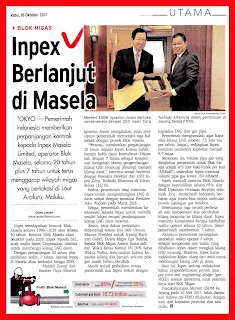Approximately 12 thousand barrels per day (bpd) from Banyu Urip Field, Cepu Block is processed at Pertamina Refinery Unit II Production Pakning River Fuel oil products (refinery) operating since 1969 are distributed to meet the needs of northern and national areas of Sumatra.
Pertamina Refinery Unit II Operation Manager Pakning Nirwansyah River said the Pakning River Refinery has an installed capacity of up to 50 thousand bpd. However, now the refinery is operated at the level of 30 thousand bpd. The supply of crude oil for the refinery comes from three fields, including Banyu Urip Field, Cepu Block.
"Refinery operations are heavily dependent on the allocation of crude (crude oil) .Now its oil supply is SLC (Sumatera light crude) 50% BUCO (banyu urip crude oil) 40%, and Lyrics 10%," he said during a media visit to the Sungai Pakning River in Bengkalis, Riau, on Tuesday (17/10).
SLC Oil comes from Minas Field run by PT Chevron Pacific Indonesia, BUCO from Cepu Block managed by ExxonMobil Cepu Limited, and Lirik from Lirik Field which is managed by PT Pertamina EP Crude oil processing at the Pakning River Refinery only reaches the primary process.
The reason, this refinery only has a crude distillation unit (crude distillation unit) that serves to separate the crude oil based on boiling point. Thus, the Pakning River Refinery does not produce Premium.
"The result is naphta 7%, kerosene (kerosene) 11%, diesel 21%, and residual 60%," said Nirwansyah.
With 30,000 bpd of crude oil supply, the naphtha output is about 2,100 bpd, kerosene 3,300 bpd, diesel 6,300 bpd, and 18,000 bpd residue.
Production of kerosene and diesel, he said, was brought to dumai or other locations according to the marketing needs of the northern region of operation. However, some of these products are also distributed to meet the needs of the surrounding area as well as private parties.
"Kerosene is preferred to be processed here, and some diesel are brought to PLN in Bengkalis, Strait Panjang, or Samak, to Siak or Long Strait depots, and to private parties," he explained.
However, the production of naphtha and residue must be brought to the Dumai Refinery. The reason is, in Dumai Refinery there is an advanced processing (secondary process) that requires the supply of naphta and residue. That is, most of the production of the Sungai Pakning Refinery is taken to the Dumai Refinery.
"So the Sungai Pakning and Dumai River is integrated," he said.
The Sungai Pakning refinery has been taken over by Pertamina since 1975. The refinery is equipped with 111,374 cubic crude oil tanks, 194,093 cubic meter tank, 35,000 deadweight jetty (DWT) and 75,000 DWT jetty. This makes the refinery capable of receiving crude oil from various source and deliver their products according to marketing needs.
IN INDONESIA
Kilang Sungai Pakning Mengolah Minyak Blok Cepu
Sekitar 12 ribu barel per hari (bph) dari Lapangan Banyu Urip, Blok Cepu diolah di kilang Pertamina Refinery Unit II Production Sungai Pakning Produk bahan bakar minyak (BBM) kilang yang beroperasi sejak 1969 ini didistribusikan untuk memenuhi kebutuhan wilayah Sumatera bagian utara dan nasional.
Manajer Operasi Pertamina Refinery Unit II Sungai Pakning Nirwansyah mengatakan, Kilang Sungai Pakning memiliki kapasitas terpasang hingga 50 ribu bph. Namun, kini kilang tersebut dioperasikan pada level 30 ribu bph. Pasokan minyak mentah untuk kilang ini berasal dari tiga lapangan, termasuk Lapangan Banyu Urip, Blok Cepu.
"Pengoperasian kilang sangat tergantung pada alokasi crude (minyak mentah). Sekarang pasokan minyaknya yaitu SLC (sumatera light crude) 50% BUCO (banyu urip crude oil) 40%, dan Lirik 10%,” kata dia dalam kunjungan media ke Kilang Sungai Pakning di Bengkalis, Riau, Selasa (17/ 10).
Minyak SLC berasal dari Lapangan Minas yang dikerjakan PT Chevron Pacific Indonesia, BUCO dari Blok Cepu yang dikelola ExxonMobil Cepu Limited, dan Lirik dari Lapangan Lirik yang digarap PT Pertamina EP Pengolahan minyak mentah di Kilang Sungai Pakning hanya sampai pada primary process.
Pasalnya, kilang ini hanya memiliki unit pemisahan minyak mentah (crude distillation unit) yang berfungsi memisahkan minyak mentah berdasarkan titik didihnya. Sehingga, Kilang Sungai Pakning tidak memproduksi Premium.
"Hasilnya naphta sebanyak 7%, kerosene (minyak tanah) 11%, solar 21%, dan residu 60%," tutur Nirwansyah.
Dengan besaran pasokan minyak mentah sebesar 30 ribu bph, maka produksi naphta sekitar 2.100 bph, minyak tanah 3.300 bph, solar 6.300 bph, dan residu 18.000 bph.
Produksi minyak tanah dan solar, dikatakannya sebagian dibawa ke dumai atau lokasi lain sesuai kebutuhan pemasaran wilayah operasi Sumatera bagian utara. Namun, sebagian produk ini juga didistribusikan untuk memenuhi kebutuhan wilayah sekitar maupun pihak swasta.
"Kerosene diutamakan untuk diolah di sini. Diesel ada yang dibawa ke PLN di Bengkalis, Selat Panjang, atau Samak, ke depot Siak atau Selat Panjang, serta ke pihak swasta," jelasnya.
Namun, produksi naphta dan residu harus dibawa ke Kilang Dumai. Pasalnya, di Kilang Dumai memang ada pemrosesan tahap lanjut (secondary process) yang membutuhkan pasokan naphta dan residu. Artinya, sebagian besar hasil produksi Kilang Sungai Pakning dibawa ke Kilang Dumai.
"Jadi Kilang Sungai Pakning dan Dumai ini terintegrasi," kata dia.
Kilang Sungai Pakning diambil alih pengelolaannya oleh Pertamina sejak 1975. Kilang ini dilengkapi tangki minyak mentah 111.374 meter kubik, tangki produk 194.093 meter kubik, jetty 35 ribu bobot mati (DWT) dan jetty 75 ribu DWT Hal ini membuat kilang mampu menerima minyak mentah dari berbagai sumber dan mengirimkan produknya sesuai kebutuhan pemasaran.
Investor Daily, Page-9, Wednesday, October 18, 2017










